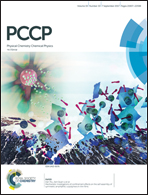Investigation of electronic transport under mechanical strain in a molecular junction composed of a polyyne bridge connected to SWCNT electrodes
Abstract
In the present work we propose a novel treatment to investigate ballistic electron transport under mechanical strain in a 1-D molecular bridge composed of alternating simple and triple bonds (polyyne) connected between two Single-Wall Carbon Nanotube (SWCNT) electrodes. Calculations with the DFT-NEGF methodology were performed in order to analyze this system at low values of mechanical strain (compression and distension) and at equilibrium length in the presence of bias voltages applied along the longitudinal direction. The results show that, while the mechanical strain displaces the energy levels and changes the band gap in the nanotube caps, the applied bias breaks the degeneracy in the nanotube cap states and defines the electrical conductance along the system. The analysis of the PDOS suggests that the main contribution to the electrical current comes from the superposition of the nanotube cap states, which is in agreement with the transmission calculation, and this device can be employed as a transistor observed in the I–V curve.



 Please wait while we load your content...
Please wait while we load your content...